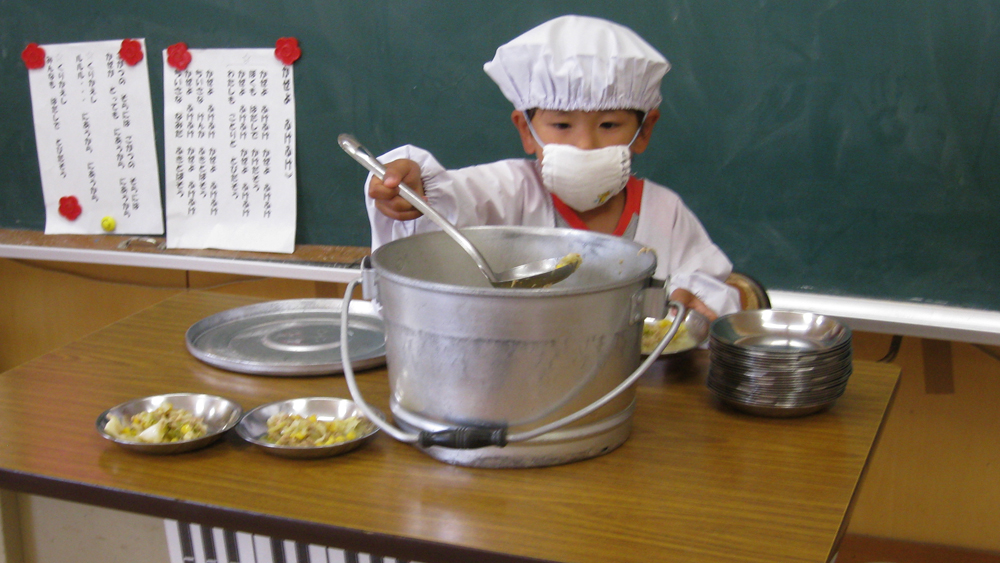Fittingly for a country with its own rich traditional cuisine, Japan takes its catered elementary school lunches very seriously. More than just a meal, lunchtime is considered on par with school lessons in its educational importance. It also helps create a bond between schoolmates in a way that perhaps only sharing a meal can do.
Tokyo school lunches are planned by the school’s nutritionist and cooked onsite by a group of staff hired specifically for that task. They prepare big pots of soup and rice and such, which the students on lunch duty retrieve from the kitchen, wheel into the classroom on a big trolley and then dish out to their classmates—it’s a bit like a portable canteen. Outside Tokyo, school lunch centers will make and distribute the food to schools.
Students serving students

The students on lunch duty dress for the part, in a white kitchen cap and a long white smock-style apron. They also don a regular, flu-use medical mask. As the other students pass by with their trays they accept a bowl of each dish from the lunch-duty kids and take them back to their desks. Utensils are also provided. When the children return to their seats, they place their tray on the luncheon mat that they have brought from home and laid out on their desks.
Also on the desk should be a pocket pack of tissues, a small hand towel and a cup. Students bring these items from home daily in a little bag that they usually hang off the side of their backpacks. Recently some schools are asking students to bring a toothbrush, too, for a post-lunch brush-up. Teachers eat the same kyuushoku catered lunch at their desks along with the students.
What’s on the menu?
So what do they eat? Most often rice, soup, a salad and a meat or fish dish. A 200-milliliter bottle of milk is included daily, but once or twice a month coffee milk or a yogurt drink is served instead. The rice dish is rarely plain white rice. Instead, it will have something such as mushrooms or wakame kelp mixed through it. It also gets served as fried rice or pilaf. Occasionally the kids get noodles instead. Bread appears as the staple about once a month and almost certainly is sweet. Dessert is served once or twice a week, most often as a piece of fruit, but occasionally as a jelly or pudding.
The soup is most often miso soup, but a variety of soups are served, including other Japanese soups, such as the clear sumashi jiru, as well as Western-style pumpkin soup and Chinese-style egg soup, which make regular, monthly appearances. Salads appear most days and come in a wide variety—wakame salad, bean sprout salad, French salad, potato salad—but all ingredients, even cucumber, are cooked to prevent an outbreak of stomach virus.
Click here to read more.
- External Link
- https://savvytokyo.com/
 Take our user survey and make your voice heard.
Take our user survey and make your voice heard.




5 Comments
Login to comment
Disco Biscuit
Mmmm….
As a trained chef working in Japan can I add that there’s a fair amount of sugar and sodium mentioned in those dishes.
Japanese milk is full of permeate, and Japanese bread contains zero nutritional value.
Eggs at best come from caged chickens being fed pelletized rations derived from left overs riddled with growth hormone and antibiotics.
The Japanese food chain is generally broken relying mostly now on cheap imports from counties with little or no food safety systems with little or no checks on investigating that what is claimed actually exists within the product.
Other imports and local long chain outdated distribution systems also mean that items can be frozen so long as to contain no mineral or vitamin benefit.
This is why supplements are so popular because most people don’t get get enough vitamins from the food they eat.
It’s quite a sad news story really because children probably shouldn’t be any where near most of the items mentioned.
fishy
My son’s high school allowed kids to eat lunch at wherever within the school property.
some ate outside, some ate at school cafeteria, some put desks together in the classroom to make a big table.
my son usually went to his friends' classroom and ate with his buddies from sports club.
i can't speak for all schools but when i was in high school (in Japan) i usually went to cafeteria and sat with friends.
sometimes teachers joined.
piskian
One of the few good things about schools in Japan.